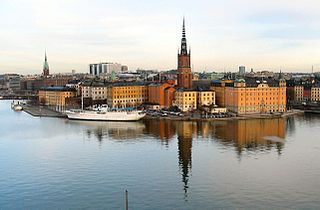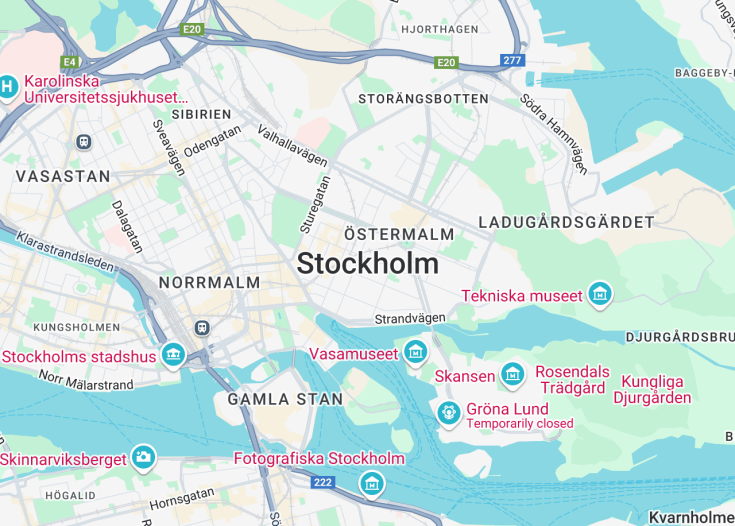Stockholm, the capital city of Sweden, gracefully balances modern progress with its rich historical heritage. Built across 14 islands connected by 57 bridges, this city combines architectural marvels, verdant spaces, and waterways in its diverse urban tapestry. Renowned for its museums, galleries, and the Nobel Prize ceremonies, Stockholm is a hub of culture and innovation. The city’s commitment to sustainability makes it a leading example of eco-friendly living, while its gastronomic scene showcases a commitment to craftsmanship and local ingredients, making it a prime destination for travelers seeking a comprehensive encounter with Scandinavian excellence.
For the best experience, visit Stockholm during late spring or summer when the weather is most favorable and the city’s parks are in full bloom.
Don’t miss exploring the historic Gamla Stan area, where you can absorb the medieval ambiance of Stockholm’s original city center.
Top things to do & see in Stockholm
Select the following sights and activities to discover best tickets and tours available in Stockholm.
Stockholm: The Venice of the North
| Country | Sweden |
| Time in Stockholm | GMT+1 |
| Language spoken | Swedish |
| Population | 975,551 (as per Statista 2023) |
| Currency | Swedish Krona (SEK kr) |
| Airports |
|
Stockholm, the capital of Sweden, enchants visitors with its remarkable blend of history and modernity. Founded in the 13th century, the city is spread across 14 islands, offering stunning views and waterways that prompted the nickname “The Venice of the North.” Stockholm is renowned for its vibrant cultural scene, historical buildings, cutting-edge design, and inventive cuisine.
The city’s history is peppered with tales of kings and queens and is the principal site for the Nobel Prize ceremonies, a global symbol of excellence in academic, cultural, and scientific advancements. Stockholm also serves as a powerhouse in the technology and music industries, famously being the birthplace of the prolific Swedish pop music scene.
Moreover, Stockholm’s commitment to sustainability can be seen in its careful urban planning, green spaces, and clean waters. The city is a pioneer in environmental stewardship, with the goal of becoming fossil fuel-free by 2040. This blend of cultural richness, history, nature, and innovation makes Stockholm not just a travel destination but a reflection of harmony between the past and the future.
Where is Stockholm?
Stockholm is strategically located on the east coast of Sweden, facing the Baltic Sea.
Distances:
| Route | Distance by car | Time by |
|---|---|---|
| Gothenburg to Stockholm | 292 miles (470 km) | Approximately 4 hours 45 minutes |
| Malmö to Stockholm | 382 miles (615 km) | Approximately 6 hours |
What is Stockholm famous for?
Aside from its breathtaking archipelago, Stockholm is famously noted for its remarkable contributions to arts, innovation, and environmental sustainability. It’s the birthplace of iconic global brands and events, including Spotify, Skype, and the Nobel Prize.
History
Up to the 13th Century: Early Settlements
Stockholm, now the capital of Sweden, has its earliest recorded roots around the 6th century as a fishing hub due to its strategic location at the mouth of Lake Mälaren. The surrounding areas were rich with fertile lands and forests, making them attractive for early settlers. However, it wasn’t until the 13th century that Stockholm began to develop as a town under the influence of the Swedish monarchy and the Catholic Church.
13th Century – 16th Century: Founding and Expansion
The formal founding of Stockholm is credited to Birger Jarl in the mid-13th century, aimed to strengthen the control over the region and protect Sweden from maritime threats, particularly the Hanseatic League. The city was strategically located on Stadsholmen Island, now known as Gamla Stan (Old Town). Stockholm quickly prospered and expanded due to trade, and in 1252, it was officially recognized as a city.
17th Century – 18th Century: Era of Great Power
The 17th century marked a golden era for Sweden under the rule of Gustavus Adolphus, whose reign saw the expansion of the Swedish Empire. During this time, Stockholm became the epicenter of administrative and political power in Sweden. The city’s architecture, influenced by the Renaissance and later the Baroque period, began to take shape.
19th Century: Industrialization and Modernization
The 19th century brought industrialization, leading to significant urban and demographic changes in Stockholm. The introduction of railways and other transportation infrastructure facilitated the growth of the city beyond its traditional limits. Stockholm turned into an important industrial hub.
20th Century – Present: Transformation and Growth
The 20th century witnessed additional transformation and growth, shaping Stockholm into a modern metropolis. Post World War II economic growth led to further expansion and modernization. In recent decades, Stockholm has developed a strong tech industry presence, known for spawning numerous global tech giants and startups. Today, Stockholm stands as a vibrant city blending historical charm with modern innovation, retaining its place as the cultural, political, and economic heart of Sweden.
Visit Stockholm
What to see and do in Stockholm
Stockholm, renowned for its stunning archipelago and rich history, offers a plethora of attractions and activities. Top sights include the historic Gamla Stan (Old Town), where cobblestone streets and medieval buildings take you back in time. The Royal Palace and the Stockholm Cathedral are also must-visits. Art enthusiasts will appreciate the Moderna Museet, home to a vast collection of contemporary art.
- Explore the Vasa Museum, showcasing a 17th-century ship.
- Take a boat tour around the archipelago.
- Visit Skansen Open-Air Museum to learn about Swedish heritage.
- Enjoy the bustling atmosphere of Norrmalm and its shopping options.
- Relax in the serene environment of Djurgården Island.
Annual events in Stockholm
Stockholm hosts a variety of annual events that reflect its vibrant cultural tapestry. The Stockholm Film Festival, one of the most influential in northern Europe, takes place in November. Summer brings the Stockholm Pride, the largest LGBT event in Scandinavia. Additionally, the Stockholm Marathon, held in early June, attracts competitors and spectators from around the globe.
Best time to visit Stockholm
The best time to visit Stockholm is during late spring and summer, from May to August, when the weather is warmest and the city enjoys up to 18 hours of sunlight a day. It’s the perfect time for exploring the archipelago and enjoying the numerous outdoor cafes and events.
Is Stockholm worth visiting?
Stockholm is certainly worth visiting for those who appreciate a blend of historical richness, scenic beauty, and modern innovation. The city offers a broad range of cultural activities and sightseeing opportunities set against a backdrop of scenic landscapes. However, visitors should be prepared for relatively high expenses as the cost of living in Stockholm can be quite high compared to other European cities. Nonetheless, the city’s charm, efficient public transportation, and the warmth of its people make it a desirable destination for many travelers.










